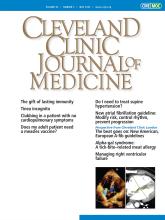Article Figures & Data
Tables
- TABLE 1
Suggested cardiac imaging tests by cardiovascular scenarios for hospitalized COVID-19 patients
Key questions before ordering imaging for ‘acute phase’
1) What is the clinical concern, and will the findings result in substantial acute change in management?
2) Will the benefits of cardiac imaging outweigh the risk of potential exposure healthcare workers and nosocomial spread of virus?
3) Are there alternative, lower-risk options with sufficient accuracy?
4) Can cardiac imaging be deferred until infectious risks have been mitigated?Acute myocardial injury Chest pain with or without electrocardiographic changes Decompensated heart failure or acute hypoxia Suspected infective endocarditis Clinical and biomarker data to guide the need for acute cardiac imaging Pattern of troponin elevation and severity of acute lung injury pattern Risk stratification of coronary heart disease, troponin criteria Established cardiovascular disease, symptoms and signs of heart failure. NT-proBNP and troponin levels Risk stratification, bacteremia organism, need for surgery Determinants for cardiac imaging: ‘acute phase' Location of patient
Emergency department or intensive care unit: cPOCUS
Regular nursing floor: TTE (if cPOCUS unavailable)STEMI: Urgent invasive coronary angiography (defer TTE), thrombolysis (do TTE)
Other acute coronary syndromes or high risk: TTE/cPOCUS
Submassive pulmonary embolism on CTA: Assess right ventricle by TTE/cPOCUSMedically refractory cardiogenic shock: TTE/cPOCUS, CCTfor refractory atrial fibrillation requiring direct current cardioversion, invasive coronary angiography for patients with high suspicion of severe coronary artery disease Submassive pulmonary embolism on CTA: Assess right ventricle by TTE/cPOCUS Discuss with infectious disease specialist if imaging would change treatment (if yes, TTE; if no, defer imaging)
TTE positive: consult infectious disease service to determine need for further imagingPatients with cardiovascular complications of COVID-19 should return for outpatient follow-up 4-6 weeks. Strategies for determining the need for PPE/repeat testing in the convalescent phase are to be determined. Cardiac imaging: ‘convalescence phase' follow-up Intermediate risk: Stress TTE, NUC, CMR
Low risk: TTE ± CMRSTEMI follow-up: TTE Intermediate risk: Stress TTE, NUC, CMR or CCT Low risk: TTE ± CMR TTE ± CMR
Consider coronary CTA for patients with intermediate-low likelihood of severe coronary artery diseaseClinical deterioration: TTE ± TEE Clinically well Follow-up with infectious disease specialist and cardiologist to determine need for follow-up imaging CCT = cardiac computed tomography, CMR = cardiac magnetic resonance imaging, cPOCUS = cardiac point-of-care ultrasonography, CTA = computed tomographic angiography, NUC = nuclear imaging, NT-proBNP = N-terminal pro-B-type natriuretic peptide, STEMI = ST-elevation myocardial infarction, TTE = transthoracic echocardiography.






